click here for a larger view
Interview with Sydney Licht
by Neil Plotkin
Sydney Licht is a painter based in New York. Ms. Licht studied at Smith College and received her MFA from the School of the Art Institute of Chicago. She is represented by Kathryn Markel Fine Arts in New York and is also a member of the still life group Zeuxis.
This past summer, Ms Licht had a solo show at Kathryn Markel and was included in two group shows which opened in December, the Small Packages show at Cumberland Gallery in Nashville, TN and The Common Object at the Maryland Institute College of Art. She will be included in the upcoming Zeuxis show Reflections, which opens at Linwood University in Missouri in February 2012.
There is also a video interview with Sydney Licht in her studio at the end of this interview.
I would like to thank Sydney very much for her time for this interview.
Neil Plotkin The classic artist story, the one here in America, is very often that a young artist moves to New York, struggles, builds a career and then moves and sets up life elsewhere. And you’ve done the exact opposite. You’ve built a career. You’ve lived around the country. You’ve raised your children. Once that was done, you moved to New York. How do you think this has benefitted you as an artist and how does living in New York now help you as an artist?
Sydney Licht I went to a liberal arts college on the East Coast as an undergraduate. The great benefit of not staying on the East Coast for grad school was that I was exposed to a different perspective at the School of the Art Institute of Chicago, which is where I went to grad school for painting. Living in Chicago was a revelation, permitting me to move past the European canon of art history.
I don’t know if you are familiar with the Art Institute of Chicago or the school there, but the professors I studied with were so open to influences outside of the European painting tradition (which I had, had a lot of as an undergraduate). I was exposed to the Field Museum of Natural History, Outsider art, Chicago Imagist paintings and art inspired by popular culture, comic books, etc.
It was eye-opening and I realized that I didn’t have to follow all those “rules” I was given as an undergrad. I could do any kind of painting I wanted. I could define my interests in a very personal way. Having this opportunity in Chicago and not going to New York right away right away helped to shape me as an artist.
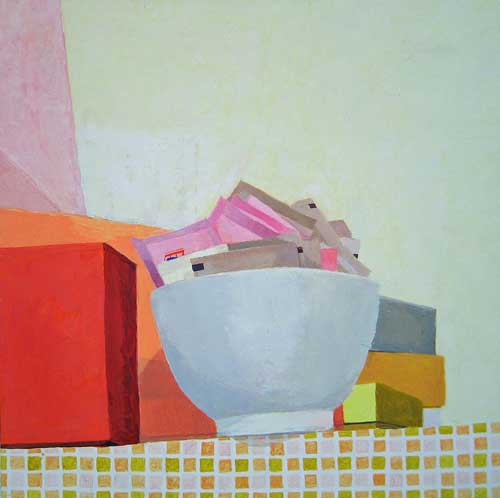
Still Life with Artificial Sweetners, 12 in. x 12 in, oil on board, 2010
NP: In the past, you told me you started out as an abstract painter. Can you talk about your transition from being an abstract painter to a representational painter?
SL: In Chicago, both while I was in grad school and after, I was painting large, neo-Expressionist, autobiographical paintings. The paintings weren’t completely abstract, however, with some evidence of imagery apparent. I called them ‘organic abstractions’. Each painting took a very long time. I was interested in the materiality of paint, and the painting process involved much scraping off and putting on; finishing a painting became so unending. I came to realize that the paintings weren’t getting resolved because I was using color arbitrarily.
To resolve this, I gave myself a problem and therefore, some structure. I decided to translate the formal aspects of one of my organic abstractions into a still life painting. The painting I first chose to translate had a huge slab of white paint cutting through a dark form, splitting it in two. To mimic that relationship in a still life, I placed two objects next to each other, touching in such a way that an interesting negative shape in between them was created.
To understand color more fully, I restricted myself to a very limited palette, using only four or five colors. I think the colors were yellow ochre, alizarin crimson, ultramarine blue, ivory black and white, essentially the primary colors plus white and black.
After this first still life, I made at least ten more in the same vein. I was reinvigorated by what I could do with such minimal means. Because I was learning so much about color harmonies with respect to value and hue, I kept working with this limited palette for at least five years.
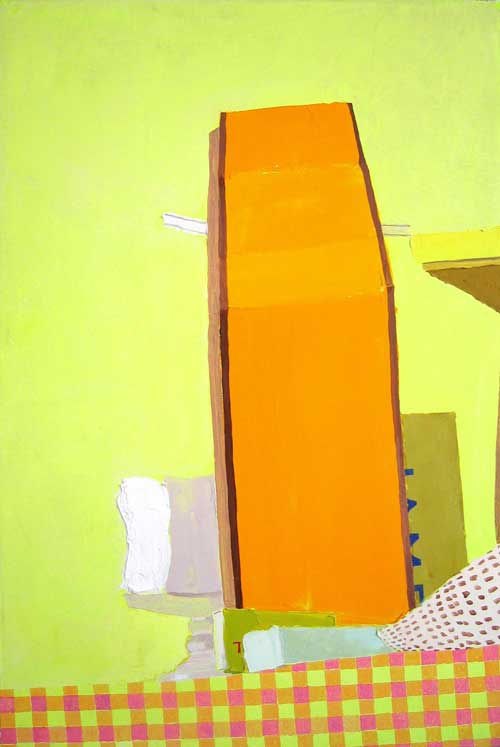
Still Life with Espresso Bag #1, 24 in. x 16 in., oil on linen, 2008
NP: Some of your colors are very keyed. Have you changed your palette a lot? How are they keyed? What kinds of colors? The yellows are very vibrant. The oranges are very vibrant.
SL: Not that much, although now, I think more about the warm and cool aspects of primary colors. I stopped using black many years ago. Usually a painting idea starts with a question. When I first started the still life project, it was, Can I make a still life that mimics the abstract ideas that I’m interested in? Or can I understand color better by using very little of it? As the questions have changed, the palette has changed.
At one point I asked myself, “Can I make a monochromatic still life with just slightly tinted hues of white?” Right after that, I really wanted to see how far I could go in pushing color intensity so the palette expanded to include a fluorescent yellow.
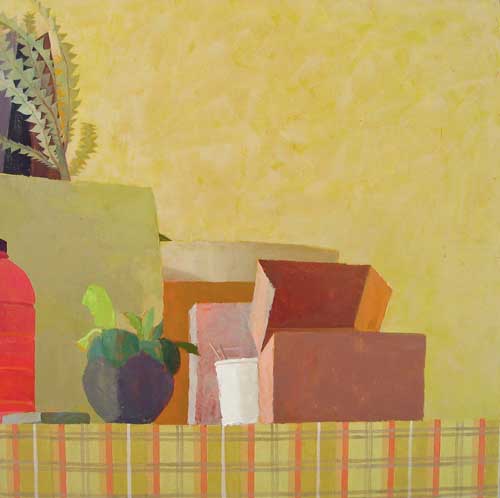
Still Life with Dessert, 30 in. x 30 in., oil on linen, 2011
NP: So you’re just using alizarin, ultramarine, yellow ochre and then you’ll add only one or two colors. You have a very tight palette then?
SL: I still use yellow ochre to which I’ve added lemon yellow. I use alizarin crimson which is a cool red and to that, I’ve added cadmium red light, which is warmer….so a cool and a warm of the same primary color dynamic are usually what’s on the palette. I’ve replaced ultramarine with cobalt blue and added manganese blue.
NP: Recently you completed a residency at Yaddo. Can you talk about the experience that you had there and how the work emerged from it?
SL: Even before I got to Yaddo, I knew I wanted to create a visual diary of the experience.
When I arrived, the first thing that the staff presented me with was a white paper bag with my name on it. It was my lunch to take to the studio. Receiving this white bag with my name on it was a very welcoming thing, like a gift.
I took the bag with my lunch in it to my studio which was completely empty and white and beautiful. A gorgeous space with nothing in it. When I took the sandwich out of the bag, it was the only visual thing in the whole room, and so I decided to paint it. I had such a good time painting it.
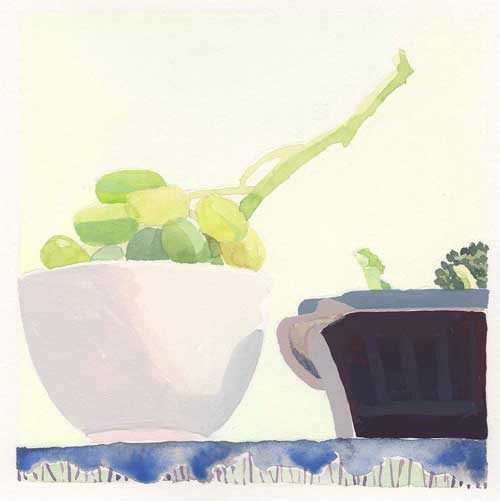
Yaddo Lunches – 6 in x 6 in – watercolor
On the second day and for the the rest of my three week stay, every morning I would pick up my lunch pail at breakfast and go to the studio. My visual diary became this ritual of painting my lunch before eating it. I would spend the morning getting warmed up by doing a watercolor of what I was given for lunch. I’d eat the lunch. Then in the afternoons, I worked on still life paintings in oil.
It was a wonderful experience. During working hours at Yaddo, everyone is expected to remain quiet in public areas so as not to disturb the other residents. All residents meet for dinner and then you can either go back to work or socialize. I found it to be very productive.
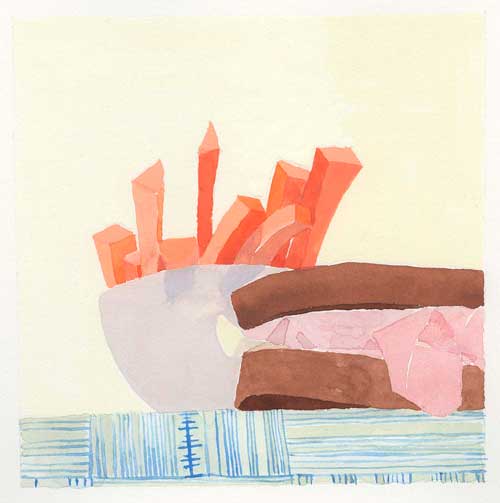
Yaddo Lunches – 6 in x 6 in – watercolor
NP: From my perspective, you’re a very established artist. You know what you’re doing. You’ve been doing it for a long time. You know how you’re going to approach things. How do you feel this residency helped move you forward? How did you benefit from it?
SL: Even though I’ve been painting for a long time, there are continual interruptions in my daily life not having to do with painting. Fighting to minimize those interruptions is a constant battle for me. When I go to a residency like Yaddo, I don’t have to think about what I’m going to make for dinner and all the other practical aspects of living my life. I’m on a mental holiday which makes room for true and consistent focus. Finding moments of focus is rare in my daily life, and easier to achieve at a residency. Also, I met some great people at Yaddo. Besides visual artists, some terrific writers, composers and performance artists were in residence while I was there.
[A group of images from this series]
Yaddo Lunches – 6 in x 6 in – watercolor
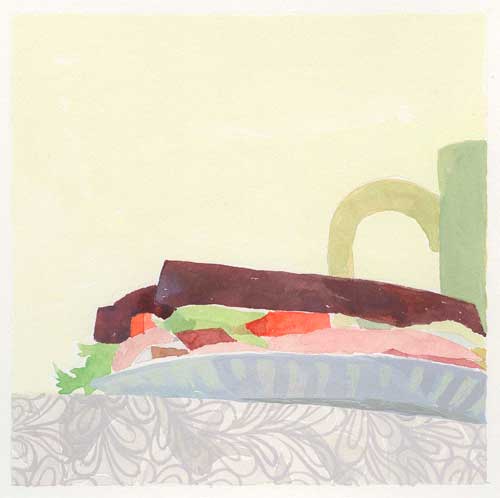
Yaddo Lunches – 6 in x 6 in – watercolor
Yaddo Lunches – 6 in x 6 in – watercolor
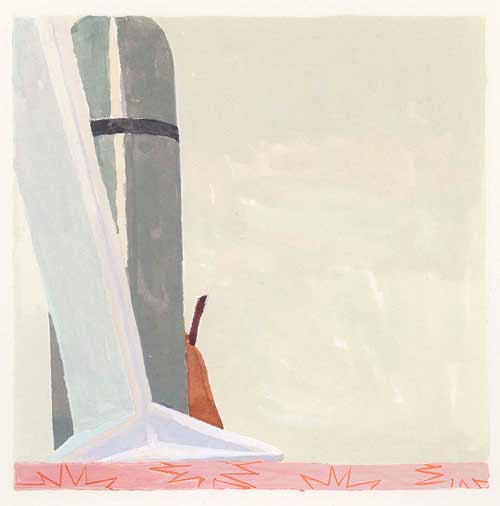
Yaddo Lunches – 6 in x 6 in – watercolor
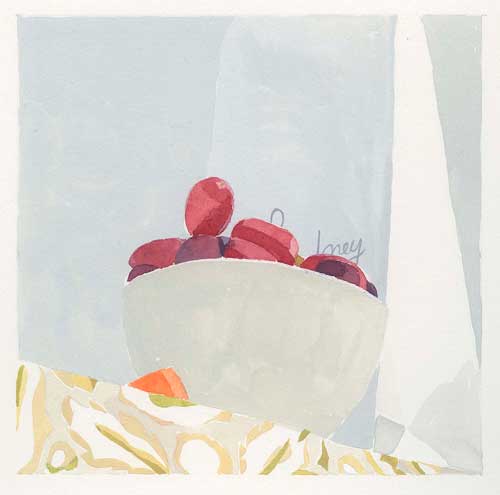
Yaddo Lunches – 6 in x 6 in – watercolor
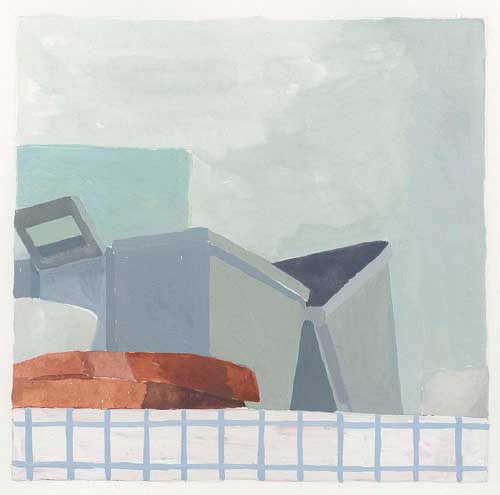
Yaddo Lunches – 6 in x 6 in – watercolor
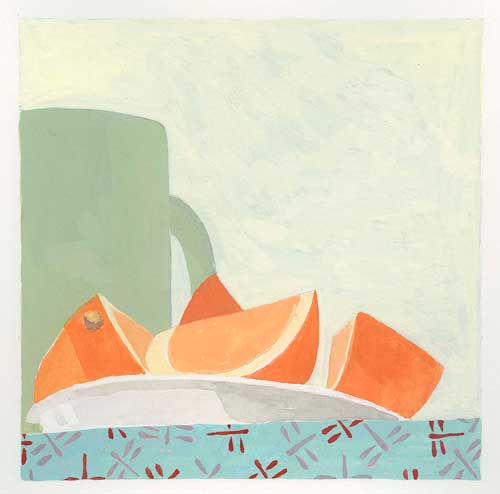
Yaddo Lunches – 6 in x 6 in – watercolor
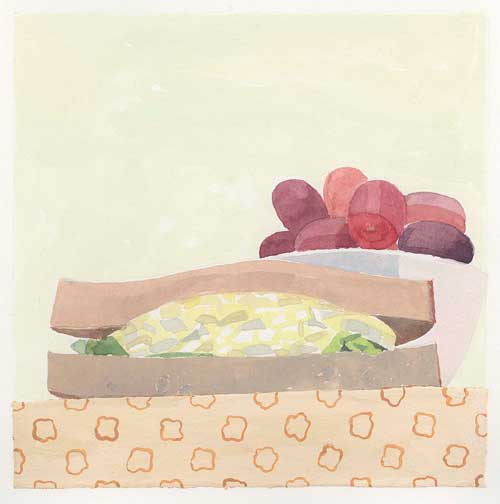
Yaddo Lunches – 6 in x 6 in – watercolor
NP: For your 2008 show, you received a favorable review in the New Yorker and the reviewer commented that Morandi was a touchstone of your work and that he looms large in your work. Anybody who is a still life painter or any kind of painter would be very happy to hear that. Rather than letting a reviewer determine your sources of inspiration, I wanted to hear where you feel that you fall in the tradition of still life painting or painting in general?
SL: I don’t think about that question a lot. I think more about where I sit in the world and about trying to incorporate the life that I live into the work, while still making the work—I hate to use the word universal but—accessible to all who are drawn to the visual. Incorporating both in each painting is a goal that I strive for. Being of my time, but also recognizing that I am a product of history as well, especially art history.
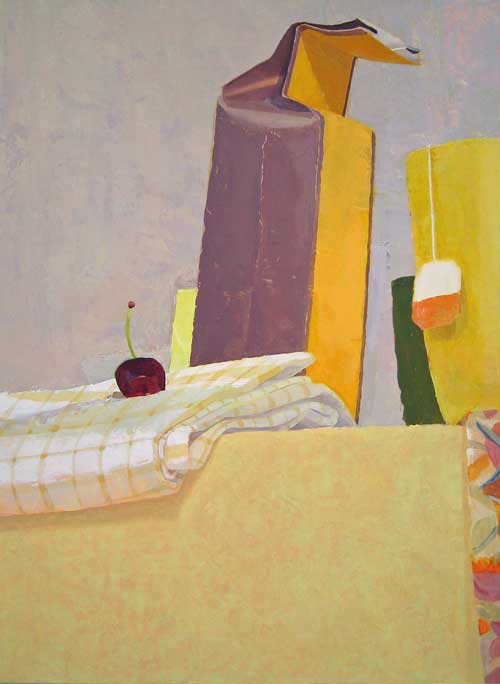
Still Life with Coffee and Tea, 16 in. x 12 in., oil on board, 2010
NP: Your work has a lot of colors poking through the surface layer of paint. Within each block of color there’s a shimmer of what’s underneath. For example, in Still Life with Coffee and Tea, you see what’s underneath a little bit. What’s your process regarding those previous layers? Are these color revisions or are they a part of how you create the blocks of color? How do you do this?
SL: Well, with each painting it’s a different story, like a different puzzle to solve. What shows through from underneath is the result of the process of finding the right hue and value relationships as a natural part of making the painting work. It’s not premeditated. I don’t paint on a colored ground. I start a painting with a palette knife, and that enables me to not get bogged down in details too quickly. At the beginning of each painting, these color/value approximations are just that…first attempts that are refined as the painting progresses through thoughtful readjustments.
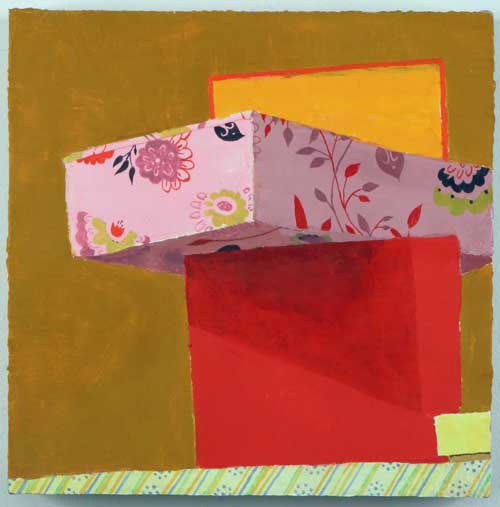
Still Life with Open Box #1, 12 in. x 12 in., oil on linen, 2006
NP: It seems that negative space has always been an important part of your composition. Is that how you approach work?
SL: I realized when I first started the still life project that the negative spaces around the objects was the real subject matter; meaning can be found in how the space around the forms impacts those forms. You’re right, that composition is the first thing I think about, and finding a compelling negative shape or space inspires me to do the painting in the first place.
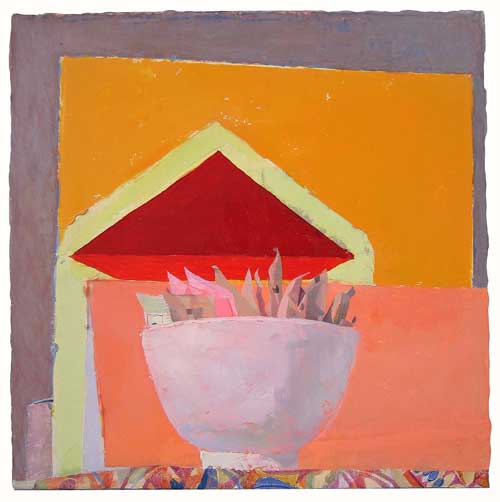
Still Life with Sweet and Low #1, 12 in. x 12 in., oil on linen, 2010
NP: The paintings are so well composed; for example to say there are four millimeters on the side of the canvas. I’m looking at Still Life with Sweet and Low. Are you looking at a viewfinder to capture that or do you draw it in?
SL: I don’t use a viewfinder. I do make a very minimal sketch; just a line drawing of how the objects relate to the edges of the picture plane and how things are relating to one another. Sometimes I’m happy with the first sketch, but often I have to do several versions of an idea to arrive at a successful arrangement of elements.
NP: On the canvas or in a painting?
SL: No, I use a sketchbook. Once I think I’ve got something, I will mix up several piles of color on the palette and go at the canvas with big slabs of paint using the knife. I rarely sketch it out on the canvas first. I learned a long time ago if I make a very detailed drawing ahead of the painting; that I’ve already answered my question and in so doing, I lose interest in the painting. Maintaining the excitement in solving a problem is key for me to stay engaged. I have restricted my drawing over the years to remain curious and surprised by each new work I make.
NP: What is the discovery that you’re looking for?
SL: Something I didn’t know before. Absolutely. The best kind of resolution is when the unexpected happens at the end of the painting process and I learn something new. If I have an initial idea and it works that’s great. At other times, I think an idea will work and it doesn’t. When that happens, I have to push myself by asking, “What is it that I’m really interested in here?”
Hard questions come up in the middle of painting. Through desperate acts, I am pushed into finding new solutions. That can mean painting out an object I first thought was crucial to the work. Or, the desperate act can be suddenly adding a piece of color at the edge to make a statement. The painting talks back and points out what I had not considered before.
NP: You’re talking about when things aren’t working. In desperation, do you abandon canvasses or do you keep beating it until it works?
SL: I keep making changes. I don’t give up on paintings, no. I mean, sometimes they’ve taken 8 or 9 years to complete but I rarely abandon a painting.
NP: You’re a member of Zeuxis, a still life group of painters. Has the exposure to other still life painters benefited you much or influenced you in any way?
SL: It has. Often, the themes of the exhibitions have pushed me in directions I probably wouldn’t have gone and forced me to look at things I may not have considered otherwise.
The Common Object exhibition currently at the Maryland Institute College of Art is a good example of that. We were all given a dishcloth that we had to include somehow, in a painting. I probably wouldn’t have placed a dishcloth in a painting without that impetus, but because I had to, it brought me back to thinking about what it means to fold and arrange cloth. This led to the paintings of tied up bundles of cloth.
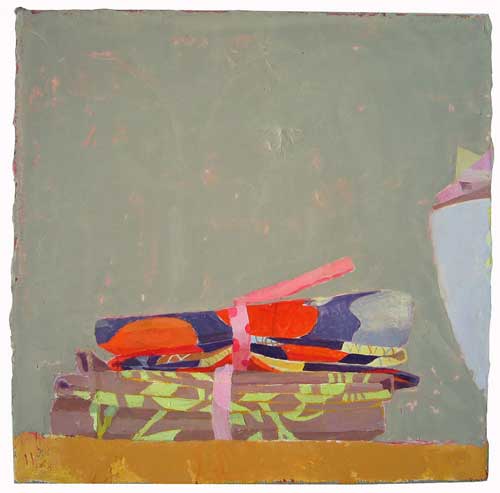
Still Life with Two Bundles, 8 in. x 8 in., oil on linen, 2010
In the Common Object painting, I kept the dishcloth relatively contained so that the original folds were still in evidence. That made me relate these folded pieces of cloth to the boxes I’ve been painting recently because like the boxes, these bundles are like beautifully wrapped gifts.
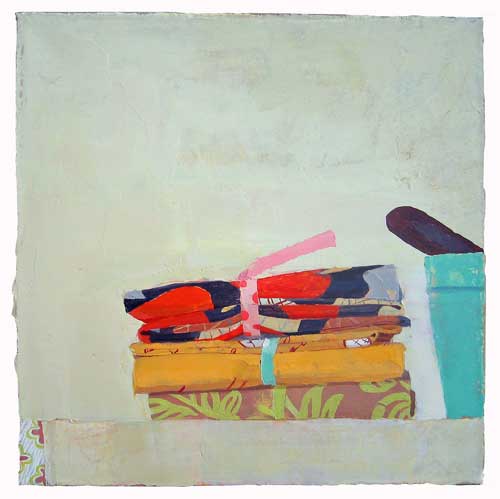
Still Life with Bundles, 12 in. x 12 in., oil on linen, 2011
NP: You keep talking about gifts and these small things. When I look at Still Life with Bundles, I think of the Japanese tradition of gifts being very well packaged. They’re small and compact. It’s all very considered. Is that something that you think about? The Asian approach or the Japanese approach in particular?
SL: No, but that’s interesting. I hadn’t thought about a Japanese influence before. I am attracted to non-Western approaches to making two-dimensional works though. I love Indian miniature paintings because of the emphasis placed on shape and pattern, flatness and color, but I hadn’t considered the Japanese approach you’re referring to. Maybe I will now.
Containers, in general, fascinate me because they bring up issues surrounding consumption. Tabletops have become resting places for fast food containers instead of elaborately prepared meals to enjoy
NP: Why have you chosen the things that you’ve chosen? Why do you use bags and packages as subjects?
SL: I choose things I’m attracted to visually and conceptually. I’ve painted food for a long time because of its association with desirability; especially certain kinds of fruit, for a very personal reason. As a child, I was very allergic to raw fruit and exposure to certain foods produced a very severe allergic reaction. Consequently, I was denied many tastes that I Ioved.
Perhaps because I was faced with this promise of the forbidden at an early age, I associate painting with desire and physicality.
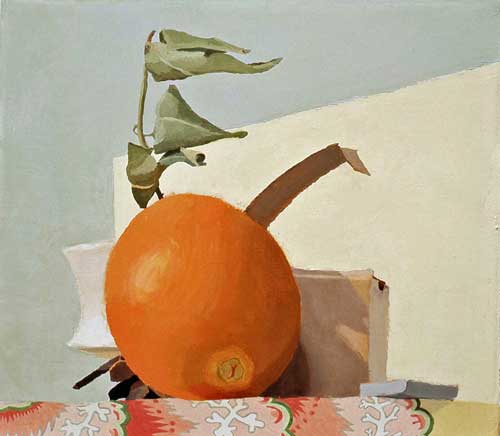
Still Life with Orange and Stem 2, 14 in. x 16 in., oil on linen, 2002
Painting images of boxes and packages is an extension of this. A package has the promise of something delightful inside just as a piece of fruit presents the promise of something delightful to taste.
We live in a culture where we see food packaged up more often than not. These packages can be so visually appealing. There’s one painting image I sent you in which an orange is pictured in front of a plain cardboard box…[Still Life with Orange]…and the shadow thrown on the box by the orange… I really love that box because of the simple way it catches the light. I’ve painted it over and over again. The light will shift on a box or bag depending upon the time of day or what it’s next to. Boxes and bags are great color catchers.
Still Life with Pasta, 12 in. x 12 in., oil on board, 2010
Video interview with interview with Sydney Licht in her studio

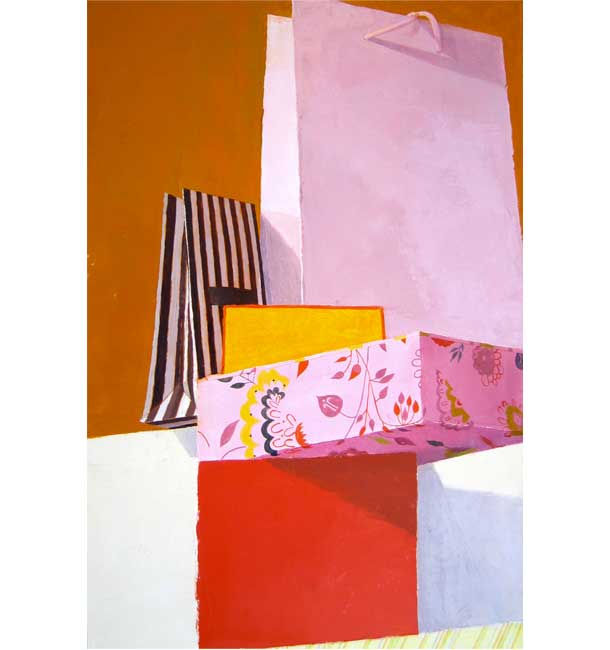
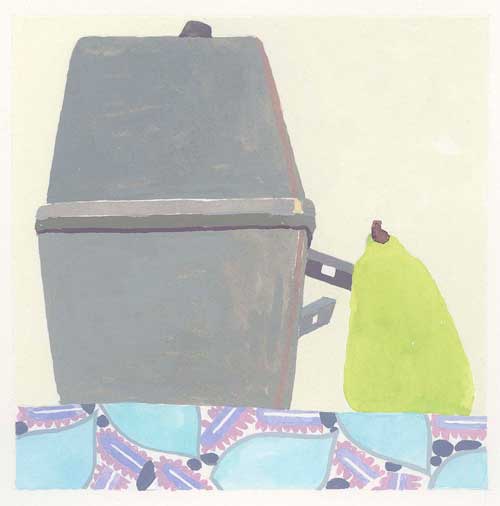
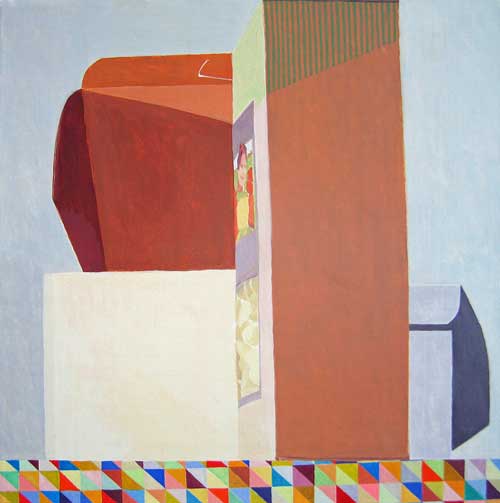




Wonderful interview. It somehow throwed me in a panic finding out about a painter whose subject matter is so similar to what I am working on now, and with such a depth and careful consideration about a variety of visual and emotional issues. Lots of input for me anyway.
Threw, sorry grammar occurs to me always too late
This is great! I have been looking for more on her for a few years now. With such great images and wonderful content I am stoked! Thanks so much for doing this interview on her!
Sydney, I am so taken with your work. It is thrilling. Absolutely beautiful. Wish I could see it in person ; ) Thanks for this informative interview – enjoyed the video too!
Such a wonderful, insightful interview and a treat to see & hear the artist talking about her work in her studio. This made my morning.
Sydney, your work is wonderful, and your words inspire. Congratulations!
Thanks to all who have posted comments so far! I really appreciate the positive feedback and very much enjoyed doing the interview. If anyone has a question, please post and I’ll try to answer.
Thought-provoking, as always, Sydney — congratulations! Wonderful to see where the new work is taking you!
Hi Sydney,
Wonderful, inspiring and very real interview. Thanks for sending it, I want to now forward it to lots of people!
Judy
hi Sydney,
Nice interview. You are so articulate and clear about complex color and painting ideas. Brava!
Wow! I’m very inspired by your bold use of color and pattern. Thank you for your thoughtful answers. It was a nice surprise to discover your work today 🙂 from, a fellow SAIC grad
Beautiful paintings! Thank you for the interview. This is such a great blog and always showcases such wonderful painters. So refreshing.
Hi Sydney,
I first saw your work in Chicago in the mid-nineties and fell in love with it immediately. I am a painter, and I have a question for you if you don’t mind.
When I look at the objects and spaces around me and frame them up with a viewfinder I find literally thousands of possible compositions that speak to me. I get all kinds of abstract ideas, and find it impossible to choose one over another to even begin a painting. Ultimately I find myself expanding the view and painting whole landscape and interior subjects. I let the subject matter guide the painting process, almost like as if the painting is a souvenir of my time with the subject and the painting, and my work suffers from a sort of nothingness. I want more direction as an artist, but cannot seem to find import in my work. It seems like from your interview and video-taped studio visit your work comes from a discipline. Would you mind elaborating on how you compose your paintings? Is there much finding going on there, or is it mostly setting up the objects after conceiving the abstract idea, like as you described your discovery in graduate school to be?
Thank you so very much!
Noel
This was a lovely interview… thoughtful questions, terrific photographs of the work, which I really like. I paint (mostly) abstract forms, & I am intrigued by the ways in which your work seems, well, abstract, still, and I love that about it. Nice balance between the two worlds… Thank you to both interviewer and Sydney Licht.
Noel,
Thanks for your question about how I compose. Sometimes I find a relationship spontaneously that I am curious about. Other times, I will set things up with a preconceived idea. While composing, I try to consider the big shapes, both positive and negative, that will determine the overall structure of the painting. But I think what you said about letting the subject matter guide the painting is also valid. Whatever works…go with it!
Thank you Sydney for your reply to my question. Good luck and God bless you with all good things… -Noel
There is great sophistication of color here. And I loved seeing her pieces hanging together in her studio, unframed, simple. One wants to own many of them, together! So inspiring – thank you, Sydney!